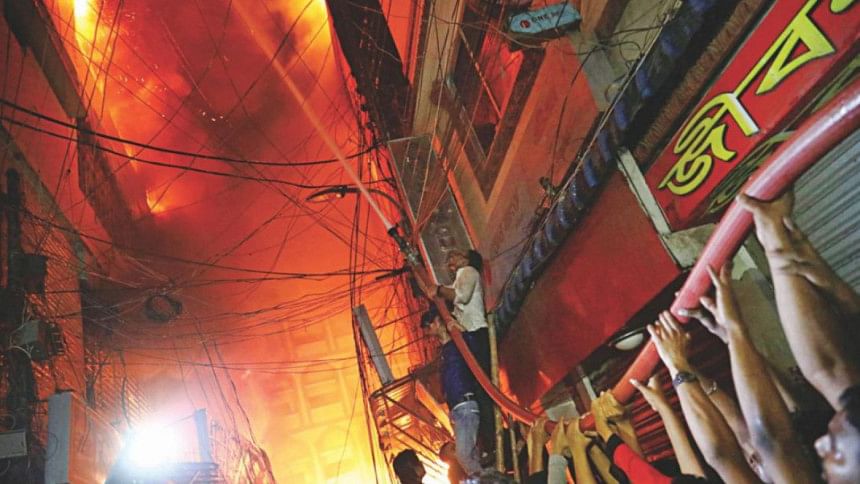Prioritise fire management in Dhaka city

I had taught at a College in New York City for six years—which used to administer fire drills every month. During the drills, each person was required to leave and evacuate the building. No exception—even if someone was taking an exam, running an analysis in the lab or in an important meeting, he/she was required to evacuate the building by law. A safety officer would check to see if each room was empty. The building was three storeyed and had labs, classrooms and offices for five departments. During office hours, there were at least 1,000 occupants in that building. Surprisingly, everyone followed the posted instructions, exit signs and completed the evacuation within 1 to 2 minutes.
One day, we evacuated the building and saw a few fire trucks arriving at the scene. We realised that it was not a drill. Later, we learned that there was a fire in one of the labs. What surprised me during the real fire incident was that no one had panicked. Everyone reacted the way they were supposed to. Regular fire drills helped everyone prepare mentally and logistically. It also increased their confidence and ability to handle a real emergency situation.
The Banani blaze showed us how unprepared we were at handling that fire incident. In every aspect, high-rise buildings like that are becoming death traps with no fire alarms, sprinklers, planned exits, and thus no evacuation plan in case of emergencies. After every incident, we blame each other endlessly.
Instead, we should learn from each case and take proper action. Failure to do so will not help advance our understanding—to make intelligent, resilient and sustainable decisions. But the question is, did we actually learn from past mistakes? The repetition of similar accidents, sometimes in the same building, tells us how much we did learn after the first incident. A few notable fire incidences are: the Bashundhara incident, BSCE building fire (2007, 2014, and 2015), Nimtoli (2010), Churihatta (this year), Banani (this year) and DSCC market Gulshan (2017 and this year).
The Banani FR tower incident was no different from the 2007 BSCE incident. The BSCE building had no planned evacuation route or proper fire detection equipment. The building's occupants did not know how to react during the emergency. According to a fire service official, a few building occupants saw fire extinguishers but did not know how to use them. The horrific fire panicked occupants and some of them manoeuvred dangerously using a cable that goes to another building across the road. Some occupants jumped from the building and lost their lives. The building authority installed a fire exit on the north side of the building after 2007—although how much work they did to install fire alarms and fireproof exits is unknown. And the building has caught fire at least three times since then.
During the Banani incident, the reaction of the occupants was no different from the 2007 incident—they seemed to not know what to do. Some of the occupants tried to escape from the building taking huge risks and eventually lost their lives. They did not know how to use fire extinguishers and there was no way to escape using the stairs.
There were too many design flaws and irregularities in that building that are being documented now by various government agencies. We are all looking forward to those reports, and their recommendations to solving those problems. But there is no easy solution to the overall problem nor can it be implemented overnight since it requires huge engineering and financial effort and sustainable reformation of policies—including making the fire department more robust, better equipped and trained. But that is an easy start.
We could start conducting fire drills on a regular basis. It helps one to be prepared. Being prepared can reduce fear, anxiety, and losses incurred during disasters such as fire emergencies. In private and government institutions, HR or admin officials can ensure that new employees are given this training when they are being hired. Many countries, in fact, require their employees to be trained and many organisations require employees to complete online training programmes before receiving their first pay-check. The advantage of this is that employees become well educated about how to fight fires and react rationally to emergency situations. Educational institutions can also conduct fire drills on a regular basis. That way, students can carry this practice onto their professional lives. Fire alarms should be made mandatory in residential areas.
All agencies responsible for handling emergencies should also have regular drills. An emergency is not the time for a dry run. Therefore, fire fighters and others should make sure that their response is flawless upon arriving at the scene.
Last but not least, government agencies should be documenting each and every crisis event with as much details as possible and regularly make even the most insensitive data public. If the data is publicly made available, anyone can use it to conduct their own analysis and share their own ideas or results. The Fire Department of New York, for example, has responded to 2.27 million fire emergencies in the last 6 years. The information they have made public includes incident time, response time, number of units, number of injuries, fire incident description, dispatch time, building description, source of fire and so on. Interestingly, the data shows how to predict for cooking fires occurring between a certain time of day, and which precautionary steps would help to reduce fire damage. It also helps the fire department plan for forthcoming incidences with more efficacy. Therefore, when they arrive at the scene, their reactions are based on experience and not assumptions.
One can always argue that the infrastructure in Dhaka is very different from other megacities. But it is high time for us to learn from other megacities and to modify and make Dhaka more sustainable.
Dhiman Ranjan Mondal, Post-Doctoral Research Scientist, Massachusetts Institute of Technology.





Comments